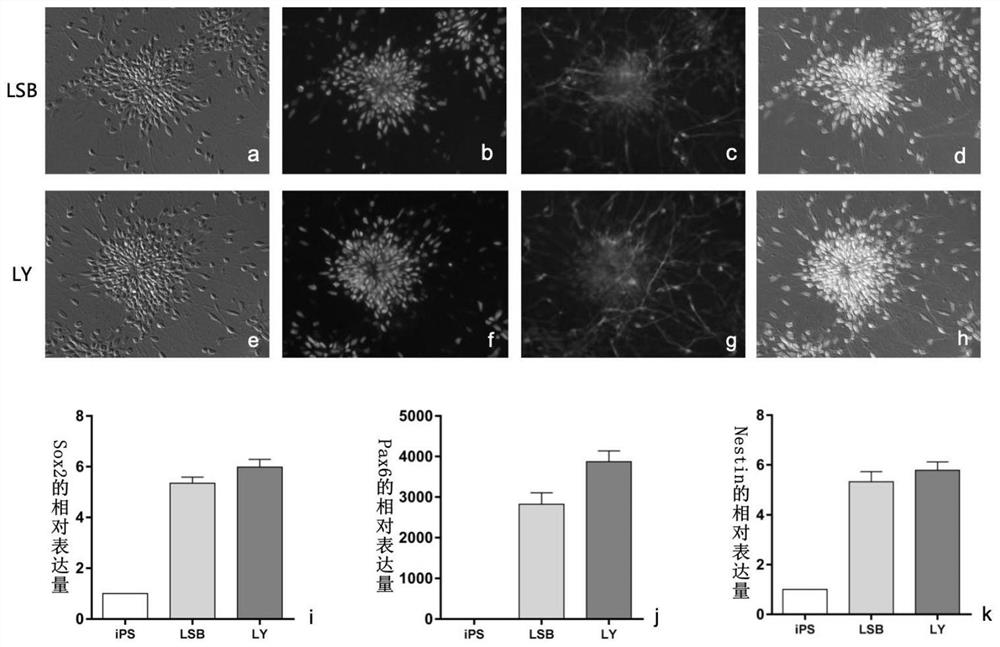Neural stem cell induced differentiation culture medium and induced differentiation method
A technology of neural stem cells and induction medium, applied in nervous system cells, biochemical equipment and methods, animal cells, etc., can solve the problems of undisclosed applications in the field of nerve regeneration, and achieve huge economic and social effects
- Summary
- Abstract
- Description
- Claims
- Application Information
AI Technical Summary
Problems solved by technology
Method used
Image
Examples
Embodiment 1
[0058] Example 1: Preparation of Neural Stem Cell Induction Medium
[0059] The formula of neural induction basal medium (hereinafter referred to as NouvNeu001): Duchenne's modified Eagle / F12 medium (DMEM / F12), minimum essential medium non-essential amino acids (MEM non-essential amino acids, Minimum EssentialMedium Non-Essential Amino Acids, Thermo Fisher, product number: 11140076), sodium chloride (SodiumChloride, 0.5g / L), sodium selenite (Sodium selenite, 13.6μg / L), insulin (22μg / ml), recombinant human transferrin (100ng / ml) .
[0060] The neural stem cell induction medium used in the present invention is prepared by adding 55nM-24μM LY2157299 (Selleck, S2230) to NouvNeu001 basal medium, and the final concentration is preferably 300nM, 500nM, 700nM, 900nM, 1μM, 2.5μM, 5μM , 7.5 μM, 10 μM, 12.5 μM, 15 μM, 17.5 μM, 20 μM or 22 μM, most preferably 12.5 μM. The above-mentioned medium is referred to as the LY induction medium for short, and the experimental group using this me...
Embodiment 2
[0062] Example 2: Induction and identification of neural stem cells
[0063] 2.1 Chemical induction of neural stem cells:
[0064] Human pluripotent stem cells include embryonic pluripotent stem cells, such as the H9 cell line and human induced pluripotent stem cells. Wherein, the human induced pluripotent stem cells used in the present invention are carried out according to the "reprogramming medium and the method for culturing reprogramming induced pluripotent stem cells" (the method in the patent ZL201910050800.7), from CD34 + Cell reprogramming was obtained.
[0065] Human pluripotent stem cells were used to coat T25 cell culture flasks with Matrigel (STEMCELL Technologies), and then placed in a 37°C incubator for more than one hour after plating. Follow 1×10 6 Cells were seeded in T25 flasks for expansion and passage.
[0066] For neural induction, use 50μg / ml polylysine (SIGMA, Cat. No.: P6407) to coat a 6-well culture plate, place the plate in a 37°C incubator and i...
Embodiment 3
[0081] Example 3: Identification of Differentiation Function of Neural Stem Cells
[0082] The neural stem cells obtained by the LY induction method in Example 2 were subjected to directed differentiation in NouvNeu001 basal medium. For neuronal differentiation, use 50μg / ml polylysine (SIGMA ALDRICH, Cat. No.: P6407) to coat a 6-well culture plate, place the plate in a 37°C incubator and incubate for more than 3 hours until cells are seeded.
[0083] 3.1 Pain receptor neurons:
[0084] The neural stem cells obtained in Example 2 were 1 × 10 5 The ratio of each bottle was inoculated into a T25 culture flask, and 3 μM CHIR99021 (Selleck, Cat. No.: S2924), 10 μM SU5402 (Tocris, Cat. No.: 3300 / 1), 10 μM DAPT (Selleck, Cat. No.: S2215) were added to NouvNeu001 basal medium, Fresh medium was replaced every 3 days until day 21. Culture conditions are 37°C, 5% CO 2 . The experimental results show that the neural stem cells obtained in Example 2 have axonal structure after differe...
PUM
 Login to View More
Login to View More Abstract
Description
Claims
Application Information
 Login to View More
Login to View More - Generate Ideas
- Intellectual Property
- Life Sciences
- Materials
- Tech Scout
- Unparalleled Data Quality
- Higher Quality Content
- 60% Fewer Hallucinations
Browse by: Latest US Patents, China's latest patents, Technical Efficacy Thesaurus, Application Domain, Technology Topic, Popular Technical Reports.
© 2025 PatSnap. All rights reserved.Legal|Privacy policy|Modern Slavery Act Transparency Statement|Sitemap|About US| Contact US: help@patsnap.com



